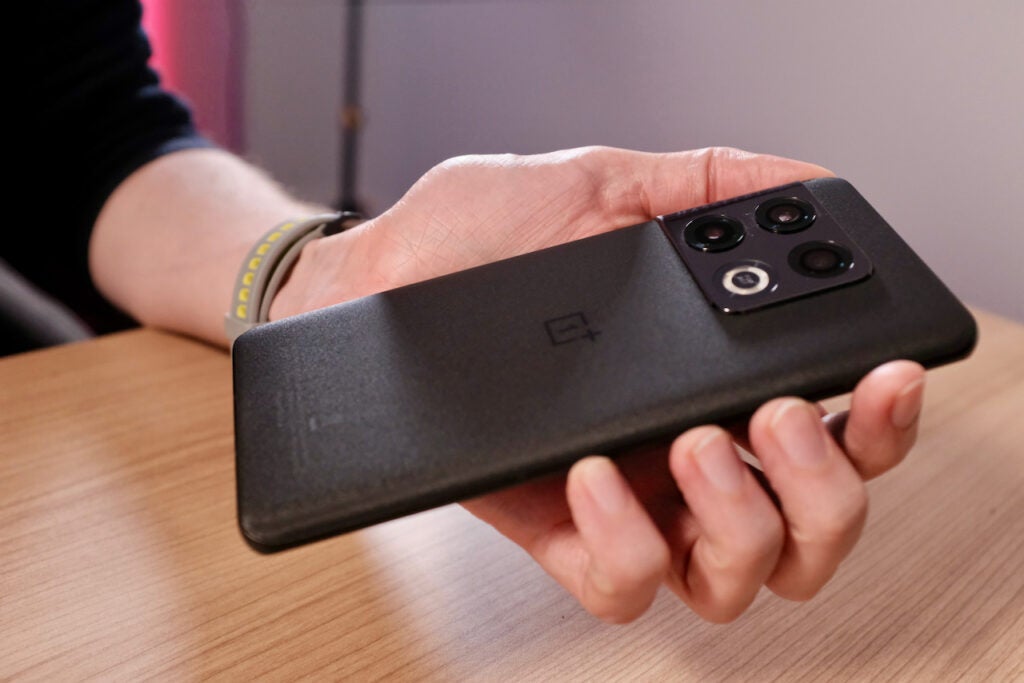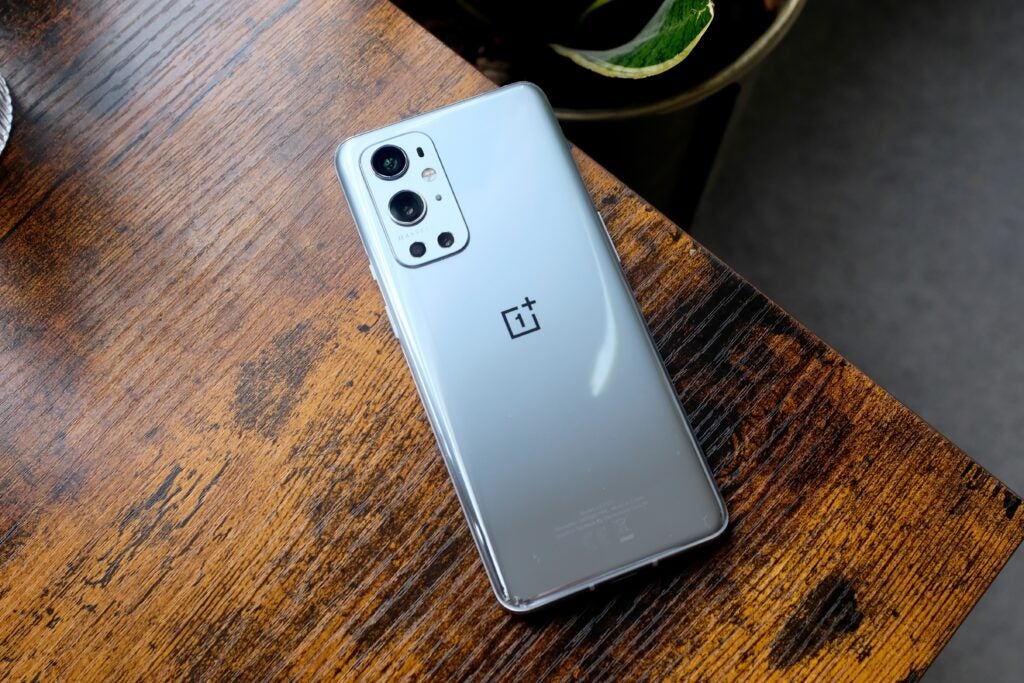OnePlus 10 Pro vs OnePlus 9 Pro: Which Pro should you go with?

Should you choose to buy OnePlus’ latest Pro edition smartphone, or is the one from last year actually better value for money?
OnePlus has a loyal fan following due its reputation of offering powerful flagship phones that tend to cost a bit less than the competition.
If you’re weighing up whether it would be worth your while to pick up the newest OnePlus 10 Pro, or to skip back a generation and go for last year’s OnePlus 9 Pro instead, then read on for our detailed breakdown of the two devices based on our rigorous reviews.
Design
There are things to like and dislike about the 10 Pro’s design. The matte rear panel is a nice touch, being impervious to greasy fingerprints and comfortable to hold at the same time; however, the massive overbearing camera module that sprawls across the back is a divisive touch that will not be appreciated by everyone.

Where the 10 Pro is bold but divisive, the 9 Pro is simply rather bland. There’s nothing about its looks that separates it from any other run-of-the-mill smartphone, but then you may prefer something forgettable to something standout. This camera module is far more discreet, and you can choose between matte or glossy variants depending on your taste.

Moving to the practicalities of each, and it’s important to note that the older model does have an IP68 rating, which the 10 Pro lacks – so we’re not to know exactly how it might deal with possible dust or water ingress.
Screen
The display quality of each device is very similar – and frankly, both are excellent.
Both LTPO screens measure 6.7 inches and have an impressively high 1440p resolution, so are very sharp. The adaptive 120Hz refresh rate on each means that the screen can be buttery smooth when it needs to be, depending on the app you’re using, but can go right down to just 1Hz when not needed in order to save battery.

What’s more, the two handsets both offer HDR10+, support over 1 billion colours, and claim to offer 1300 nits peak brightness in certain HDR instances, so colours look exceptionally vivid while the displays are plainly visible even under glaring sunlight.
One of the very few differences is that the OnePlus 10 Pro has a screen made of Gorilla Glass Victus while its predecessor is cast in Gorilla Glass 5, so that is one minor upgrade in favour of the latest handset.
Camera
Historically, cameras have been a bit of a weak spot among OnePlus phones when compared to the best camera phones.

The OnePlus 9 Pro showed some improvement in this department, perhaps thanks to the brand’s partnership with Hasselblad (which continued to the 10 Pro); colours remain more vibrant rather than natural, but there is still plenty of detail packed into each shot and the ultrawide lens is a particular highlight, producing crisp shots that aren’t as distorted as some of the “fisheye” results you get from peers. All that said, the telephoto camera with 3.3x optical is a real letdown, with very poor levels of detail.

The OnePlus 10 Pro’s camera is certainly versatile, but it still doesn’t consistently hit the heights that we’d been hoping for. For one thing, the colour palette between the three sensors is markedly different, and for another it seemed that the detail simply wasn’t as richly reproduced in this camera as in other flagship phones.
Overall both have relatively capable cameras, but they are nonetheless left in the shade by the best phones in the field; if the camera is your top priority then you might want to check out some of the smartphones recommended in our best camera phones round-up.
Performance
Both devices offer excellent performance standards, with each one running on the then-flagship chip from Snapdragon at the time of launch; that’s the Snapdragon 888 for the OnePlus 9 Pro, and the Snapdragon 8 Gen 1 for the OnePlus 10 Pro.
As you can see from the below results, the older model actually slightly overperforms the newer one in terms of CPU scores (those measured by Geekbench), though the GPU scores (measured by 3DMark) are significantly lower.
OnePlus 9 Pro vs OnePlus 10 Pro: Performance Benchmarks
Whichever of these two phones you choose, you can expect very capable performance for general tasks or for gaming.
Battery Life
We found the battery life on both handsets to be sufficient, although the OnePlus 10 Pro does have a significantly larger capacity of 5000mAh compared to the 4500mAh of its forerunner. Both easily gave us enough juice for a whole day’s usage, without fear of running out before the end of the day.
When it comes to topping up the battery, these phones excel once again thanks to their brilliant fast-charging capabilities. The OnePlus 9 Pro boasts speedy 65W wired charging and 50W wireless charging, but the OnePlus 10 Pro eclipses even that with its incredible 80W wired charging and 50W wireless charging.
This feature is a brilliant bonus when buying a OnePlus phone, as just a few minutes of charge can give your battery a much-needed boost.
Price
Though the industry-wide trend seems to be for smartphones to inevitably increase year-on-year, OnePlus’ latest release was a pleasantly surprising exception to the rule.
While the OnePlus 9 Pro was released with a recommended retail price of £829, the OnePlus 10 Pro actually undercut that with a pricetag of just £799. However, as it’s been a year since the release of the 9 Pro it has naturally fallen in price since then; you could snap it up for as little as £719 at the time of writing, which makes it quite the bargain.
Verdict
Clearly, the OnePlus 10 Pro is not a quantum leap beyond its predecessor. The design is arguably a step back, the screen is very similar, CPU performance is similar, and the camera did not offer the improvement we were really hoping for.
There are, however, improvements to the battery capacity, its fast-charging speeds, and the GPU performance. If these are of crucial importance to you then the 10 Pro might be the better buy, but for the majority of customers it seems that the 9 Pro may offer a better deal now that it’s fallen in price.
Should you choose to buy OnePlus’ latest Pro edition smartphone, or is the one from last year actually better value for money?
OnePlus has a loyal fan following due its reputation of offering powerful flagship phones that tend to cost a bit less than the competition.
If you’re weighing up whether it would be worth your while to pick up the newest OnePlus 10 Pro, or to skip back a generation and go for last year’s OnePlus 9 Pro instead, then read on for our detailed breakdown of the two devices based on our rigorous reviews.
Design
There are things to like and dislike about the 10 Pro’s design. The matte rear panel is a nice touch, being impervious to greasy fingerprints and comfortable to hold at the same time; however, the massive overbearing camera module that sprawls across the back is a divisive touch that will not be appreciated by everyone.

Where the 10 Pro is bold but divisive, the 9 Pro is simply rather bland. There’s nothing about its looks that separates it from any other run-of-the-mill smartphone, but then you may prefer something forgettable to something standout. This camera module is far more discreet, and you can choose between matte or glossy variants depending on your taste.

Moving to the practicalities of each, and it’s important to note that the older model does have an IP68 rating, which the 10 Pro lacks – so we’re not to know exactly how it might deal with possible dust or water ingress.
Screen
The display quality of each device is very similar – and frankly, both are excellent.
Both LTPO screens measure 6.7 inches and have an impressively high 1440p resolution, so are very sharp. The adaptive 120Hz refresh rate on each means that the screen can be buttery smooth when it needs to be, depending on the app you’re using, but can go right down to just 1Hz when not needed in order to save battery.

What’s more, the two handsets both offer HDR10+, support over 1 billion colours, and claim to offer 1300 nits peak brightness in certain HDR instances, so colours look exceptionally vivid while the displays are plainly visible even under glaring sunlight.
One of the very few differences is that the OnePlus 10 Pro has a screen made of Gorilla Glass Victus while its predecessor is cast in Gorilla Glass 5, so that is one minor upgrade in favour of the latest handset.
Camera
Historically, cameras have been a bit of a weak spot among OnePlus phones when compared to the best camera phones.

The OnePlus 9 Pro showed some improvement in this department, perhaps thanks to the brand’s partnership with Hasselblad (which continued to the 10 Pro); colours remain more vibrant rather than natural, but there is still plenty of detail packed into each shot and the ultrawide lens is a particular highlight, producing crisp shots that aren’t as distorted as some of the “fisheye” results you get from peers. All that said, the telephoto camera with 3.3x optical is a real letdown, with very poor levels of detail.

The OnePlus 10 Pro’s camera is certainly versatile, but it still doesn’t consistently hit the heights that we’d been hoping for. For one thing, the colour palette between the three sensors is markedly different, and for another it seemed that the detail simply wasn’t as richly reproduced in this camera as in other flagship phones.
Overall both have relatively capable cameras, but they are nonetheless left in the shade by the best phones in the field; if the camera is your top priority then you might want to check out some of the smartphones recommended in our best camera phones round-up.
Performance
Both devices offer excellent performance standards, with each one running on the then-flagship chip from Snapdragon at the time of launch; that’s the Snapdragon 888 for the OnePlus 9 Pro, and the Snapdragon 8 Gen 1 for the OnePlus 10 Pro.
As you can see from the below results, the older model actually slightly overperforms the newer one in terms of CPU scores (those measured by Geekbench), though the GPU scores (measured by 3DMark) are significantly lower.
OnePlus 9 Pro vs OnePlus 10 Pro: Performance Benchmarks
Whichever of these two phones you choose, you can expect very capable performance for general tasks or for gaming.
Battery Life
We found the battery life on both handsets to be sufficient, although the OnePlus 10 Pro does have a significantly larger capacity of 5000mAh compared to the 4500mAh of its forerunner. Both easily gave us enough juice for a whole day’s usage, without fear of running out before the end of the day.
When it comes to topping up the battery, these phones excel once again thanks to their brilliant fast-charging capabilities. The OnePlus 9 Pro boasts speedy 65W wired charging and 50W wireless charging, but the OnePlus 10 Pro eclipses even that with its incredible 80W wired charging and 50W wireless charging.
This feature is a brilliant bonus when buying a OnePlus phone, as just a few minutes of charge can give your battery a much-needed boost.
Price
Though the industry-wide trend seems to be for smartphones to inevitably increase year-on-year, OnePlus’ latest release was a pleasantly surprising exception to the rule.
While the OnePlus 9 Pro was released with a recommended retail price of £829, the OnePlus 10 Pro actually undercut that with a pricetag of just £799. However, as it’s been a year since the release of the 9 Pro it has naturally fallen in price since then; you could snap it up for as little as £719 at the time of writing, which makes it quite the bargain.
Verdict
Clearly, the OnePlus 10 Pro is not a quantum leap beyond its predecessor. The design is arguably a step back, the screen is very similar, CPU performance is similar, and the camera did not offer the improvement we were really hoping for.
There are, however, improvements to the battery capacity, its fast-charging speeds, and the GPU performance. If these are of crucial importance to you then the 10 Pro might be the better buy, but for the majority of customers it seems that the 9 Pro may offer a better deal now that it’s fallen in price.








